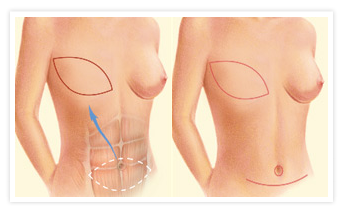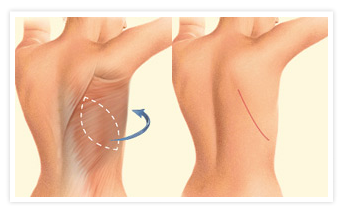Breast Reconstruction Surgery with Dr. Frank J. Piro
Offering Surgical Breast Reconstruction in the SF Bay Area
 Breast plastic and reconstructive surgeon Frank J. Piro, MD, provides breast reconstruction surgery for women who have undergone lumpectomy or mastectomy to treat breast cancer. By offering breast cancer survivors (and those who have undergone preventative mastectomy) breast reconstruction surgery, the compassionate plastic surgeon hopes to help patients restore their positive body image, sound emotional health and quality of life overall.
Breast plastic and reconstructive surgeon Frank J. Piro, MD, provides breast reconstruction surgery for women who have undergone lumpectomy or mastectomy to treat breast cancer. By offering breast cancer survivors (and those who have undergone preventative mastectomy) breast reconstruction surgery, the compassionate plastic surgeon hopes to help patients restore their positive body image, sound emotional health and quality of life overall.
Dr. Piro treats patients seeking surgical breast reconstruction using one of several available approaches to breast reconstruction surgery. During the initial visit, Dr. Piro will review the patient's medical and cancer treatment history as well as her unique anatomical needs and aesthetic desires before collaborating with the patient to formulate a breast reconstruction surgical plan that best meets her needs.
I came to Dr. Piro with a medical diagnosis that was personally difficult. I found him to be not only professional but compassionate as well. His patience and knowledge helped me feel comfortable and I trusted Dr. Piro completely to handle my surgery. The staff was warm and friendly, making me feel comfortable in the office. They were extremely helpful with scheduling and all of my questions were answered with knowledge and thoroughness. I had breast reconstruction after bilateral mastectomies. I am extremely happy and pleasantly surprised. This surgery has made me complete again. At the beginning of the journey I wasn’t sure I would ever feel that way again. Now I do. Many thanks to Dr. Piro and his staff.![]()
—D. C.
Breast Reconstruction Procedure Options
Before beginning any type of breast reconstruction surgery, Dr. Piro administers general anesthesia so the patient does not experience any pain and is completely comfortable throughout the entire procedure. He typically performs breast reconstruction surgery on an outpatient basis. The surgery can take several hours, depending on the complexity of the surgical approach taken, the patient's anatomy and her aesthetic goals for surgery.
Most women who have undergone mastectomy or radiation therapy to treat breast cancer will have an insufficient amount of tissue on the chest wall to support and cover a breast implant. Therefore, Dr. Piro must usually use either a flap technique or tissue expansion to create enough tissue to coat and support the breast implant used in reconstructive surgery.
With one of the available flap techniques, Dr. Piro repositions the patient's own skin, fat and muscle tissue to create breast matter or to cover the existing breast tissue. The two most common flap breast reconstruction techniques involve either the use of a TRAM flap or a latissimus dorsi flap.



TRAM flap. With this technique, Dr. Piro uses donor skin, fat and muscle tissue from the patient's abdomen to reconstruct the breast. Depending on individual factors, such as the patient's body type, Dr. Piro may either leave the TRAM flap attached to the original blood supply, tunneling northward through the chest wall, or completely detach the flap, sculpting it into a breast mound.
Another option is for Dr. Piro to use the DIEP or SGAP flap technique to graft skin and fat tissue from the abdomen or buttock to the chest, without using any muscle tissue.
Latissimus dorsi flap. With this technique, Dr. Piro uses donor skin, fat and muscle tissue from the patient's back, tunneling the tissue to the mastectomy site. With this approach, the tissue stays attached to the initial donor site, keeping the blood supply intact.
Although a tissue flap can occasionally be used to reconstruct the breast mound as mentioned above, it is more commonly used to provide support for and coverage of a breast implant.
Tissue expansion. Some patients would rather undergo a multi-step tissue expansion procedure instead of using a tissue flap to create the needed coverage for a breast implant. Although tissue expansion allows for a quicker, easier recovery period than flap procedures do, it is a lengthier reconstruction process overall.
With tissue expansion, Dr. Piro inserts an expanding device, called an "expander," into the mastectomy site. Over a period of four to six months, he gradually fills the device via an internal valve, thus expanding the skin tissue needed to cover a breast implant. Sometimes, patients use the expander as a breast implant. More often, a second surgical procedure is required to switch out the expander with a long-lasting breast implant.
More About the Breast Reconstruction Procedure
Once there is a sufficient amount of tissue to support and cover the breast implant, Dr. Piro can surgically place a breast implant to create a breast mound. He may use a saline or silicone implant in addition to or instead of a flap technique.
Once the breast mound is created, either with a flap technique alone or with a breast implant, the plastic surgeon completes the breast reconstruction process by reconstructing the nipple and areola (the darkly pigmented skin surround the nipple). He closes any required incisions with stitches, and dresses the breast area with bandages and possibly a surgical bra for added support.
What to Expect After Breast Reconstruction Surgery
Postsurgical breast reconstruction patients should arrange to take one to two weeks off from work or their normal routine. They should get as much rest as possible and avoid strenuous activity, including heavy lifting.
The breast area may be swollen, bruised, sore or numb. These are normal symptoms that should gradually go away over time. Breast reconstruction patients can take oral pain relievers as prescribed by Dr. Piro to alleviate any initial postoperative discomfort. A pain pump may also be used when medically appropriate. Those who have undergone breast reconstruction surgery can gradually resume their daily routine, including fitness regimen, as advised by Dr. Piro.
Healing takes several weeks as swelling diminishes, and the breast shape and positioning improve. Continue to follow all Dr. Piro's instructions, and be sure to keep all scheduled follow-up appointments.
Although breast reconstruction is an effective way to reconstruct breasts, there are certain things to keep in mind:
- A reconstructed breast will not feel exactly the same as natural breast tissue and will not have the same sensation.
- Both mastectomy and breast reconstruction surgery require incisions that can leave scars. However, scars should fade greatly with time.
- If only one breast was affected by breast cancer treatment, Dr. Piro can reconstruct that single breast. He may recommend breast augmentation with an implant, breast lift or breast reduction for the opposite breast to improve the symmetry of both breasts.
Candidacy for Surgical Breast Reconstruction
Only an experienced plastic surgeon such as Dr. Piro can establish whether a woman is a suitable candidate for breast reconstruction surgery. In general, however, suitable breast reconstruction candidates include women who:
- Have an overall positive self-image but want to restore breasts after lumpectomy, mastectomy or other type of breast cancer treatment
- Have a positive outlook and are looking for aesthetic improvement, not necessarily perfection
- Are in suitable physical and mental health, and do not have additional medical conditions that may impair healing
- Are not pregnant or breastfeeding
- Do not smoke or are prepared to quit smoking for several months before and after surgery
First and foremost, appropriate candidates for breast reconstruction surgery comprehend the risks and rewards of the procedure, have realistic expectations for the surgical outcome and are pursuing breast reconstruction for personal reasons (not someone else's).
Start on Your Way to Restoration Today
Dealing with the breast cancer diagnosis and treatment is difficult. However, breast reconstruction surgery can be an effective way to help restore the look of the breasts as well as a positive self-image and great quality of life.
Breast reconstruction is not for everyone, but as a breast cancer survivor, you deserve to know your options. If you do opt for reconstructive surgery, you may find that it is a rewarding conclusion to the arduous journey you have been on. Don't wait any longer to restore your body and your spirits.
To schedule a personal consultation with Dr. Piro to learn more about your breast reconstruction surgery options, please contact his practice by calling (650) 652-8230 today.
 To learn more about our Plastic Surgery Services, please contact us at (650) 652-8230 today to schedule an appointment.
To learn more about our Plastic Surgery Services, please contact us at (650) 652-8230 today to schedule an appointment.